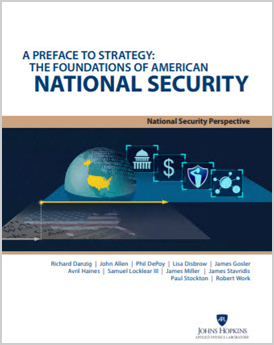Press Release
How Can the U.S. Call Upon Its Strengths as It Looks Forward to an Uncertain Future?

Download "A Preface to Strategy: The Foundations of American National Security" (PDF) >>
“A Preface to Strategy: The Foundations of American National Security,” a new paper from the Johns Hopkins Applied Physics Laboratory’s Senior Fellows, examines the nation’s core strengths and how they should shape new strategies.
When the Johns Hopkins Applied Physics Laboratory was founded during the early years of World War II, and throughout the Cold War and into the new century, international threats and national goals were clear. The United States served as the world’s preeminent superpower and unparalleled leader in defense, technology and economic might.
The world today is very different. To understand this world, its challenges and America’s unique advantages to navigate it, the Laboratory commissioned “A Preface to Strategy: The Foundations of American National Security,” authored by all 11 of APL’s Senior Fellows.
This paper identifies premises that shaped — and continue to shape — America’s national security institutions, processes and strategies. It explains how conditions that underlie these premises no longer apply but describes how this nation can call upon its core strengths to navigate the first half of the 21st century.
“This paper is a different kind of contribution for us,” said APL Director Ralph Semmel. “It gives us a more complete strategic picture, which can inform our research and development decisions affecting military capabilities.”
The paper identifies numerous challenges to America’s preeminence as a global leader, from the expansion and continuous nature of warfare to the rise of international interdependence and the permeation of technology. To meet these challenges, the authors identify and encourage readers to be mindful of particular national strengths, including America’s values, human capital, economic might, and unparalleled military forces and intelligence agencies.
Former Secretary of the Navy Richard Danzig, a primary author, observed: “Many strategies proceed from fear; they identify threats and deduce requirements. This document is more optimistic: It focuses on America’s strengths. And it is more operational: We have a better ability to amplify and apply our strengths than we do to control the behavior of others.”
“While the paper represents the opinions of our senior fellows, it gives all of us at APL and the entire national security community a lot to think about,” Semmel said. “The ideas discussed can help us focus our efforts more effectively on key areas that could profoundly and positively impact our nation and the world for generations to come.”
The authors of “A Preface to Strategy” are:
- Richard J. Danzig (as primary writer), former Secretary of the Navy
- John R. Allen, former Commander, ISAF Afghanistan
- Phil E. DePoy, former President and CEO of the Center for Naval Analyses
- Lisa S. Disbrow, former Secretary of the Air Force (Acting)
- James R. Gosler, former Director, Clandestine Information Technology Office at the CIA
- Avril D. Haines, former Deputy National Security Advisor
- Samuel J. Locklear III, former Commander, U.S. Pacific Command
- James N. Miller, former Under Secretary of Defense for Policy
- James G. Stavridis, former NATO Supreme Allied Commander
- Paul N. Stockton, former Asst. Secretary of Defense for Homeland Defense and Americas’ Security Affairs
- Robert O. Work, former Deputy Secretary of Defense
